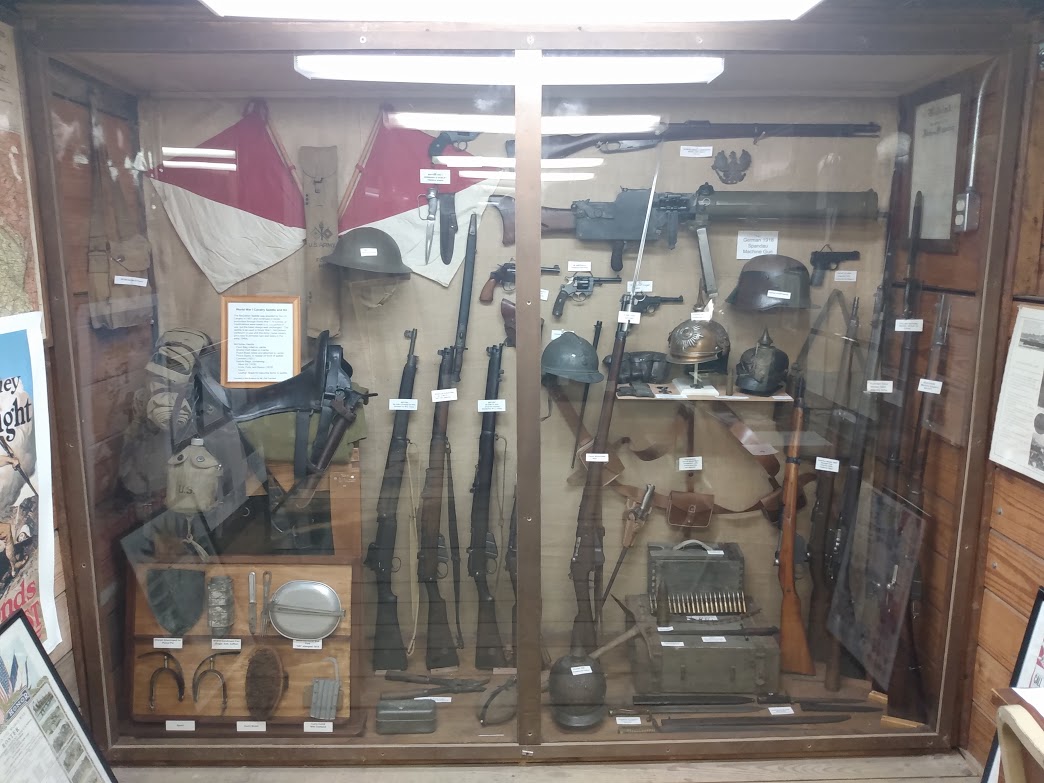British No. 3 Mark 1 Pattern 14 Rifle:
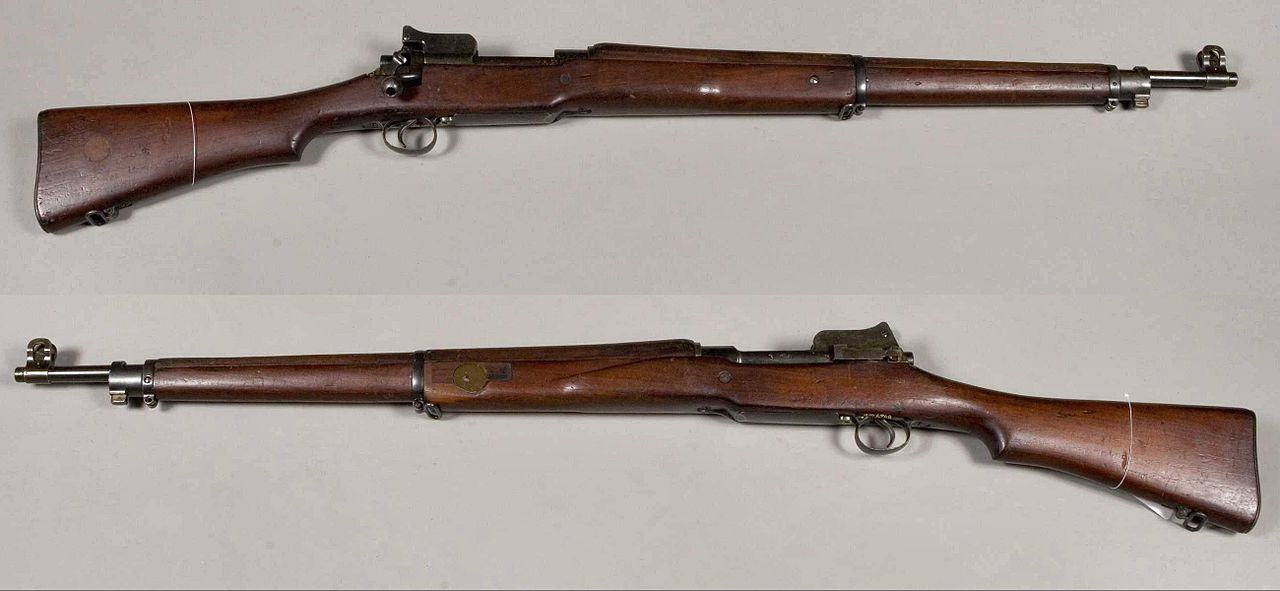
The No. 3 Mark 1 was a British service rifle of the First World War. This rifle is a bolt action rifle with an internal five round magazine. It was made by contract by companies in the United States. A shortage of industrial capacity led the British Government to contract with US manufacturers Remmington, Winchester and Eddystone to augment their supply of small arms. Each factory produced parts for these rifles that varied slightly and in many cases they were not interchangeable. This rifle was declared obsolete in 1947
British No. 1 Mark III Rifle:
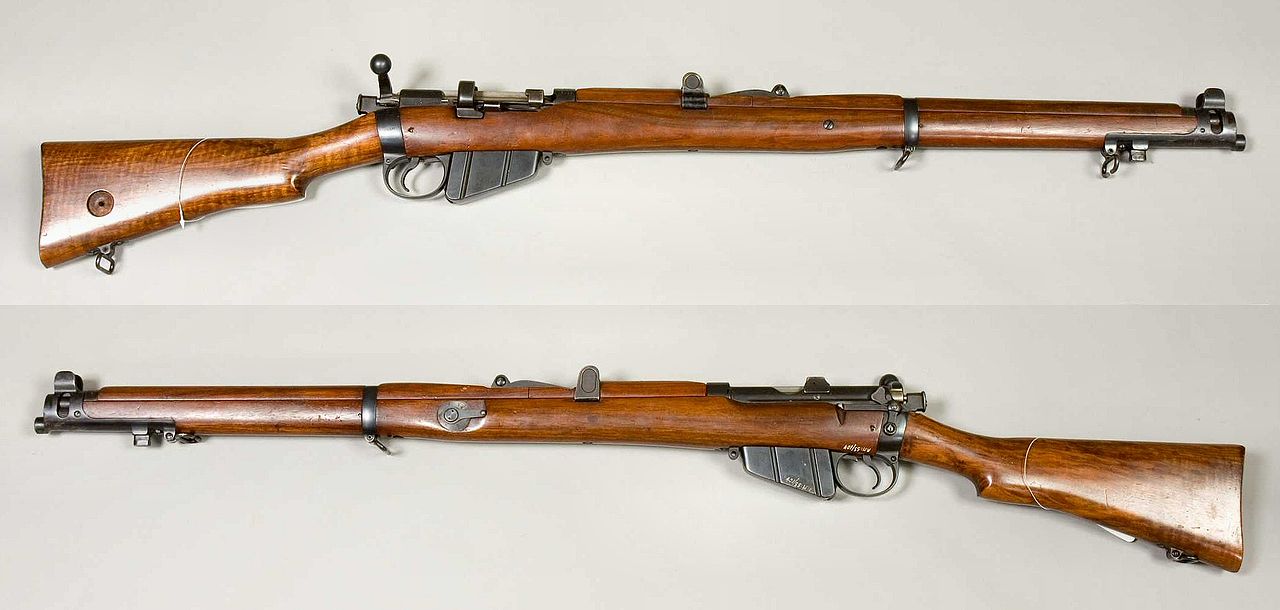
The British No.1 Mark III is one of a series of rifles which were modified, tested, and redesigned to meet varying demands of battle. Each of the rifles of this series were designated with numbers, marks and asterisks. The Lee-Enfield series began in 1895. Over the next 60 years, more than 13 million were manufactured. The Enfield series replaced the earlier, similar Lee-Metford bolt action rifles. The name of the rifle is derived from the designer's name, James lee and the small arms manufacturing location at Enfield Lock, Middlesex. The No. 1 Mark III is a short magazine Lee-Enfield (SMLE) standardized in 1907. The rifle weighs just over 8 pounds and has a 25 inch barrel. The SMLE has a 10 round detachable magazine and is chambered for the .303 cartridge. The No.1 Mark III sights were adjustable for ranges up to 1,000 meters. The rifle was first employed on the battlefield in 1914 during World War 1. The Lee-Enfield is an accurate rifle and is very effective when used by skilled marksmen. The 10 round magazine had greater capacity than many other conventional rifles of the time. The No.1 Mark III was a well made quality weapon with tight tolerances which required extra care in adverse conditions encountered in trench warfare to keep it functioning.
British No. 2 Mark IV .22 Caliber Rifle:

Number 2 MK IV rifles are externally identical to .303 SMLE MK III rifles except modifications to fire the .22 caliber cartridge. These rifles were developed to train cadets about firearms safety and marksmanship using a .22 cartridge, which was much cheaper than the standard .303 cartridge. These were initially created by modifying obsolete Magazine Lee-Metford and Magazine Lee-Enfield rifles, but were later made using SMLE rifles.
French M 1892 8mm Carbine:
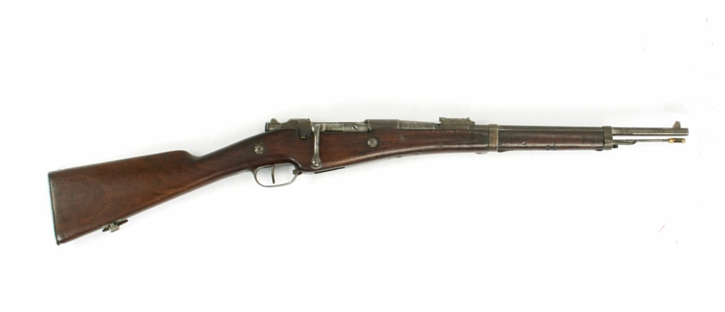
The M1892 carbine was designed by Algerian railroad worker Emile Berthier. The M1892 was lighter, smaller and easier to handle than the standard Lebel rifle of 1914. Large full size rifles such as the Lebel were awkward in the confines of the trench warfare environment. This rifle fired the 8 x 50 mm cartridge fired by the Lebel using an Mannlicher style en-bloc 3 round magazine roughly similar to those used in an M1 Garand. The Mannlicher magazine was easier and faster to load than a conventional tubular magazine. When empty, the magazine clip fell from an opening in the bottom of the receiver. An unusual detail in the design is the omission of a safety, dictated by French colonial military doctrine. Instead the rifles were intended to be carried with the chamber empty. The rifle is just three feet long and was suitable for cavalry, machine gun and artillery crews and other non-front line troops. These rifles were widely adopted and very successful.
Webley .455 MK I 1887 Revolver:

The Webley MK I is a standard service revolver issued to British and Commonwealth military personnel. The Mark I was adopted in 1887. The Webley is a top break pistol design in which the pistol is reloaded by opening the revolver from the top using a catch lever. This action also extracts the spent cases. The .455 caliber model is the most powerful of all of the Webley series of top-break pistols. The Mark I had a four inch barrel and “birds beak” style grips. The .455 cartridge produced a relatively slow muzzle velocity of 620 ft per second. It was not intended for long range accuracy, but it had great stopping power at short range. This cartridge was one of the most powerful military cartridges ever produced. The Webley top break series revolvers were in service for over 75 years. These revolvers were known to be very rugged and reliable in harsh conditions. A notable feature is the lack of a safety in the Webley series.
Smith and Wesson M1917 .45 Revolver:

The US Military solicited design proposals from both Smith and Wesson, and Colt to augment the supply of the standard M 1911 semiautomatic pistol with a revolver firing the .45 cartridge. Using the same cartridge was intended to simplify logistics. The Colt and Smith and Wesson revolver designs were very similar, but did have some notable differences. Both revolvers are designed with a heavy frame and use a double action. The Smith and Wesson Revolver is slightly more complicated and took longer to disassemble and reassemble. The Colt has a slightly larger grip and a heavier barrel. The Smith and Wesson revolver has a shoulder machined into it to headspace on the case mouth of the rimless cartridge and does not require the use of half-moon clips. From 1917 until 1919, Smith and Wesson produced over 150,000 1917 revolvers. The M1917 Revolver was issued to officers, infantrymen, and support personnel. These revolvers were used extensively in World War 1, World War 2, the Korean War, and even saw some use by Tunnel Rats in the Vietnam War.
French M1892 Ordinance Revolver:

The Model 1892 was also known as the Lebel Revolver and the St Etienne 8MM. The Model 1892 is a French service revolver produced by Manufacture D’armes de St Etienne. This revolver was standard issue for officers during WW1. The Model 1892 is a solid frame double action revolver with the cylinder on a separate frame which swings to the right for loading similar to modern revolvers. The left sideplate of the revolver swings back to allow oiling and cleaning of moving parts. These parts are individually numbered to indicate order of assembly. The revolver was first issued in 1893 and was still used by French police until the mid 1960’s. The Model 1892 is a well finished pistol and fires an 8mm round with power similar to the .32 ACP which is smaller than many other military revolvers of the time. About 350,000 were manufactured between 1892 and 1924.
This revolver was used in the 2018 Strasbourg Terrorist Attack.
French Model 1916 8mm Rifle:

The M1916 rifle is an upgraded design of the M1892 intended to address some unfavorable characteristics of the M1892. The three round magazine which had no protruding mechanism was favored by some but was generally considered too limited as it required frequent re-loading. The opening in the bottom of the receiver also allowed dirt and other contaminants to enter and foul the mechanism. The M1916 was equipped with a larger 5-round en-bloc magazine with a spring loaded trap door to keep out dirt. These rifles were still in use during World War Two but were eventually replaced by the MAS-36.
German Erfurt 1917 Luger Pistol:

Luger pistols were designed by Georg Luger and manufactured at Deutsche Waffen und Munitionsfabriken (DWM). The Luger was manufactured by several nations from 1898 through 1948. These pistols were introduced with the 7.65 Parabellum cartridge, but were later modified to utilize the 9mm Parabellum cartridge. The Luger was adopted by the German and Swiss Armies in early 1900. Luger pistols made in Switzerland and Germany were manufactured with high standards and craftsmanship using tight tolerances and quality materials. As a result these have a long service life. The Erfurt Luger was manufactured at the Royal Erfurt Arsenal in Central Germany. The Erfurt Arsenal was equipped with the finest machinery available to manufacture military weapons. The arsenal began manufacture of the Luger pistol in 1910. Almost 500,000 Luger pistols were manufactured here.
German Spandau Machine Gun:
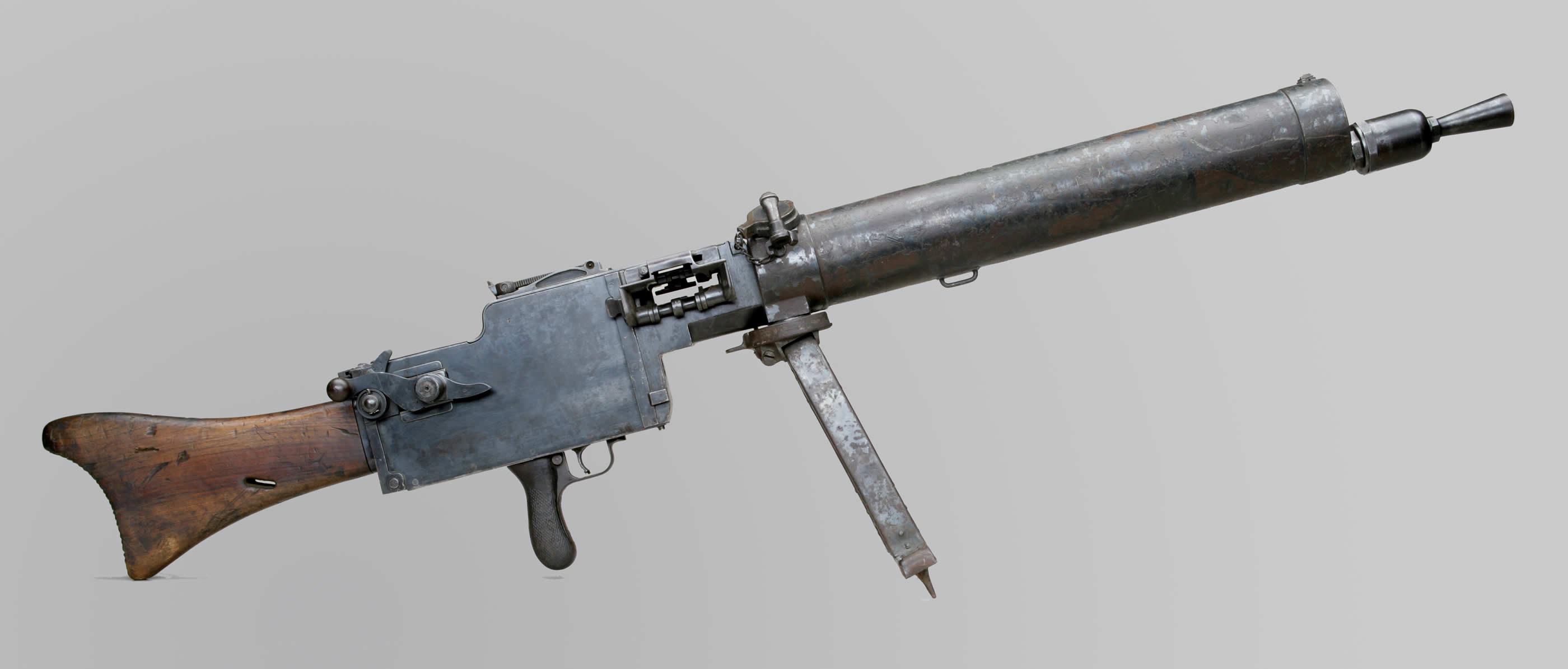
The Maschinengewehr 08 or MG 08 was the German army’s standard machine gun during WW I and was an adaptation of the famous Maxim Machine gun. It is also referred to as the Spandau Machine gun since it was manufactured by the government's Spandau Arsenal. The Spandau was designated as the MG 08 as 1908 was the year in which it was adopted. The MG 08 was water cooled and required 3.7 liters (0.713 liquid Gallons) of water to operate. The MG 08 had a firing rate of between 500 and 600 rounds per minute. The gun used 250 round fabric ammunition belts and fired 7.92 x 57 mm ammunition. The gun used short barrel recoil and toggle lock during operation and would fire continuously as long as the trigger was depressed. The practical range of the weapon was 2000 – 3600 meters. Although associated with trench warfare, the MG 08 was a multipurpose weapon and was employed in aircraft, static defensive positions, and by the Navy, but was primarily considered an artillery weapon. The MG 08 was reported to perform with great effectiveness in the Russo-Japanese War in 1905. It was designed to be operated by two trained infantrymen on the ground in prone position. Despite the fact that, being water-cooled it was bulky, heavy (the MG08 with its tripod mount weighed 143 pounds without water) and somewhat difficult to move, it was the most heavily used German machine gun of WW I. The capability to provide sustained fire over long periods earned them the nickname “Devil’s Paintbrush”.
German Gewehr Model 1888 7.92 mm Rifle:
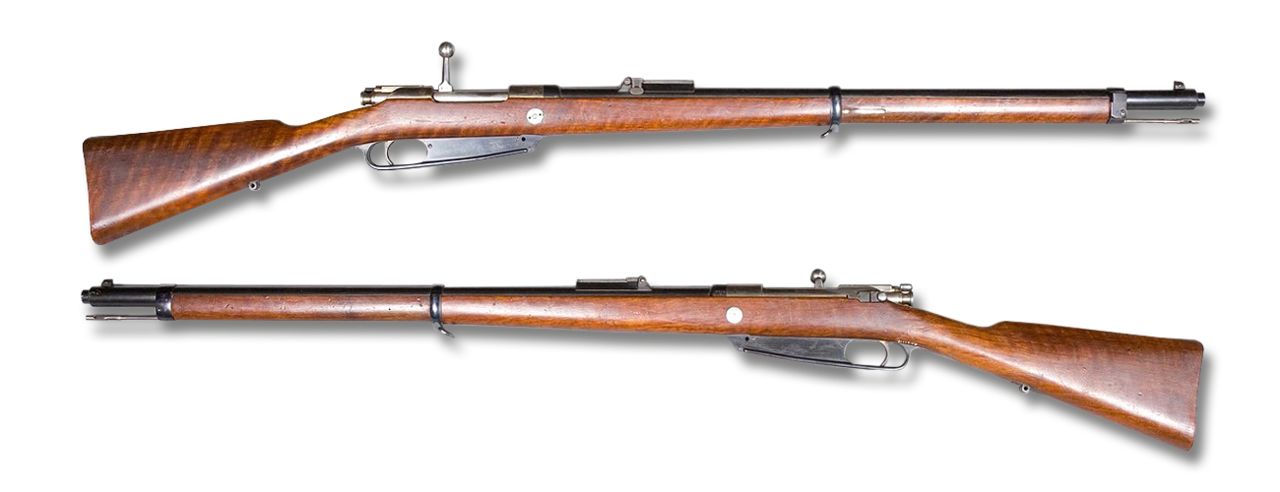
The 1888 Gewehr Rifle was a late 19th century bolt action rifle adopted in 1888. The introduction of the Gewehr 1888 Rifle was a response to the French adoption of smokeless powder invented in the late 19th century, which created an arms race between Germany and France. The first step for Germany to mitigate the advantage experienced by the French smokeless powder, the Germans developed a new cartridge. This new cartridge was the M88, a rimless 8 mm cartridge which utilized a 226 grain round nose projectile. This was later replaced by the 7.92 x 57mm Mauser cartridge. The M1888 employs a Manlicher-style en-bloc loading system which allowed re-supply of ammunition using stripper clips. One unique feature of the rifle is the sheet metal tube which encases the barrel and prevents it from touching the stock. This unusual feature also served as a moisture trap which promoted rusting. The Gewehr 1888 served as a front line weapon for German infantry until it was replaced by the 98K. After the full adoption of the 98K, many 1888 Gewehr rifles retained useful service by other foreign nations including China, Turkey and Spain.
German Langenhan Pistol:

The Langenhan Pistol is a German pistol designed by Friedrich Langenhan. The pistol was used by German military and police personnel. The design is similar to the FN M1900. These were produced from 1914 to 1917 during which time, about 55,000 were produced. The design incorporates a blowback mechanism and is fed by an 8 round magazine. It is interesting to note that the slide is held in place by one screw which can vibrate loose and allow the slide to fly off of the pistol when fired.
Austro-Hungaria Steyr Model 1895 Carbine:

This rifle is the carbine version of the M1895 straight pull rifle designed by Ferdinand Ritter von Mannlicher. It uses the same bolt mechanism as the infantry version of this rifle. As is the case with the infantry rifle, the carbine version has an internal five round magazine fed from the top using clips. The M1895 was the product of many evolutionary design changes, one of which was the strengthening of the bolt mechanism to accommodate higher chamber pressure for new smokeless powder cartridges. The carbine is just over 39 inches long and weighs approximately 7 pounds. This rifle was adopted by the Austro-Hungarian Army throughout World War 1. Many of these rifles saw continued use into World War II where they were issued to second line and reservists units. As is the case with the infantry rifle, the straight pull mechanism gave these rifles a high rate of fire. The M1895 was initially chambered for the 8x50 mm Mannlicher cartridge.
Austrian Model 1895 Steyr Straight Pull Infantry Rifle:

The Model 1895 Straight Pull Rifle is a bolt action rifle designed by Ferdinand Ritter von Mannlicher. The rifle is unique in that its design features what was considered a revolutionary straight pull bolt mechanism instead of the more conventional rotating bolt handle. The straight pull design allowed the operator of the rifle to cycle the bolt with just a single backward and forward motion. This resulted in an increased rate of fire. With adequate maintenance, the rifle performed extremely well and was reliable and sturdy. It is reported that during design trials, some rifles were able to fire over 50,000 rounds without lubrication. The receiver utilized helical grooves to force the bolt to rotate when retracted. The rifle is equipped with a five round en-bloc clip, but due to its design could not be fed single rounds. The rifle fires an 8 x 50 mm Mannlicher cartridge.
Austrian Model 1886 Steyr Kropatschek Infantry Rifle:

The Kropatschek Rifle is a bolt action repeating rifle with a tubular magazine. The design of this rifle was influenced by the German Mauser M71/84. These rifles were built for Portugal by Steyr. The rifle fires an 8mm black powder round, but is capable of firing the same round using smokeless powder. The sights have a maximum range setting of 2200 meters. The Kropatschek Rifle is the basis for the French Lebel Rifle.
Italian Vetterli Model 1870 6.5 mm Rifle:

The Vetterli Rifle was the standard service rifle for Italian military forces from 1870 through 1887. The M1870 was a single shot bolt action rifle which fired the 10.4 mm center fire cartridge. The design was later modified to utilize a 4 round internal magazine loaded from stripper clips. The clips were made of metal and wood and were removed when all ammunition was expended by pulling a string built into the clip. During World War 1 some of the M1870 rifles were modified to fire the 6.5 mm smokeless powder cartridge. A sleeve was inserted into the barrel and the magazine design of the Carcano rifle was implemented.
Russian Mosin Nagant Model 1891 Rifle:
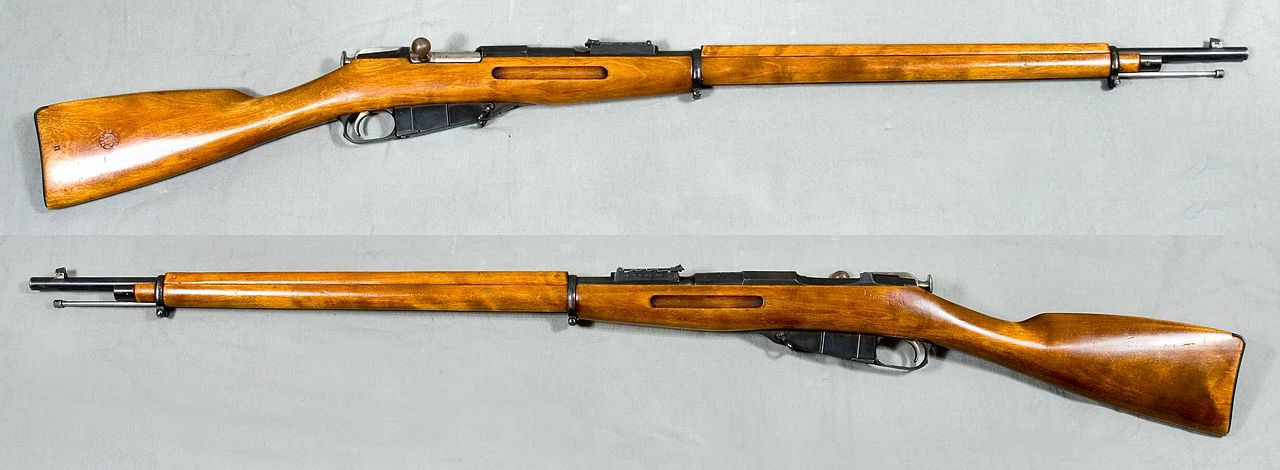
The Model 1891 Mosin Nagant Rifle is a 5-shot, bolt action rifle. The Mosin Nagant fires the 7.62 x .54 mm cartridge and utilizes an internal magazine. This rifle was developed in 1882 thru 1891 and was used by the armed forces of Russia and the Soviet Union. The Mosin Nagant is one of the most numerous rifles ever produced with an estimated 37 million produced. This rifle has been used in conflicts all over the world and despite its antiquity, is still in use today. The design of the Mosin Nagant is actually a blending of design elements developed by two competing weapons designers, Mosin and Nagant. The rifle has some similarities to the Gewehr 1888 and the Italian Carcano Rifle. Ammunition is fed into the rifle in single rounds or more often by use of a 5-round stripper clip. The rifle was actually referred to as the Russian Three Line Rifle M 1891. The Term “Mosin –Nagant “ was an invention of Western literature. Production of the rifle began in 1892. Due to shortcomings in Russian domestic industry, 750,000 Mosin-Nagant rifles were produced by US firearms manufacturer Remington before the October Revolution. Excess rifles produced in the US after the revolution were purchased by the US Army. A modernized version of the M1891 was developed and saw widespread use in World War Two. The Mosin Nagant was eventually succeeded by the SKS rifle, and later the AK series rifles.
German Artillery Luger:

The Artillery Luger, also known as Lange Pistol P08, was a German manufactured Luger pistol authorized for production by the Kaiser in 1913. The P08 is a variant of the Luger series and was equipped with a 7.9 inch barrel. The pistol had an eight position rear sight calibrated to 800 meters. These pistols were typically issued with a leather holster and shoulder stock. For close combat the shoulder stock was connected to a lug on the pistol frame and the pistol was used as a carbine. The Artillery Luger was originally intended as a self defense weapon for artillery crews. It was lighter and less cumbersome than the K98 rifle. During World War One, the P08 Luger was frequently issued to Storm Trooper infantry units equipped with the new larger 32 round Trommelmagazin “Snail Magazine”. Production of the P08 ceased in 1918. The P08 was eventually replaced by the MP18 sub machinegun. However, production of the P08 was restarted in the early 1920’s.
Note: the P08 was issued to artillery troops for the Shah of Iran in the 1930’s.



